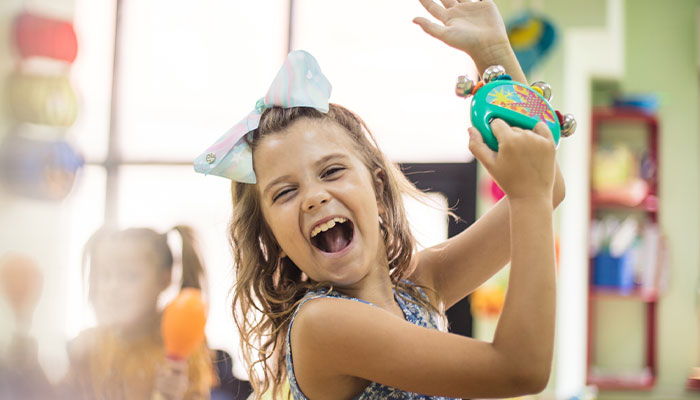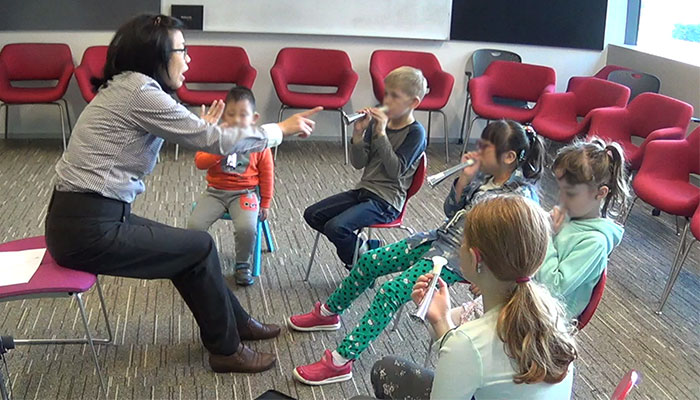Imagine yourself in a primary school playground, surrounded by the chattering, shouts and laughter of children. The bell rings, there is a stampede of footsteps on the asphalt, and amid this chaos, you tune out all the distracting sounds and manage to hear your friend speaking to you. You have just successfully heard ‘speech-in-noise’.

Happy place: Music holds great therapeutic potential, and can improve communication skills.
But children with hearing impairments have a vastly different experience of this typical scenario. Even with cochlear implants or hearing aids, they still experience significant challenges, such as hearing sounds in a noisy environment like the school playground.
They tend to do very well in quiet environments, but struggle to hear well when there is noise. They may be unable to hear the teacher in a loud classroom, or interact well with peers in the playground.
But what if I told you music could help this?
Music holds great therapeutic potential, and therapy based on music is associated with improved communication skills.
Interest in understanding the importance of music in the deaf community has deep historical roots, even predating the field of audiology, with the earliest formal studies way back in 1848.
Music training may be particularly helpful for hearing as it requires students to be receptive to quick and detailed changes in sound.
Music holds great therapeutic potential, and therapy based on music is associated with improved communication skills. Music therapy is a multisensory and engaging training method, that offers wider benefits that specifically target ‘speech-in-noise’ perception.
Program improves perception
Together with a team of supervisors from Macquarie University, I established a music therapy program for early primary-aged children who used either hearing aids or cochlear implants. Over the 12-week program, 14 children were offered in-person weekly sessions, and an app they could use at home to guide them through various musical activities such as singing, dancing, playing instruments and creating their own pieces of music.

Instrumental: Over the 12-week program, 14 children had in-person sessions as well as an app to guide them at home.
The tasks the children performed sometimes used multiple senses, but sometimes relied entirely on hearing. For example, they listened to instruments hidden in bags and had to identify the instrument based only on the sound. This uses their ability to recognise the character, or timbre of a particular sound.
The children showed significant improvements in various aspects of their sound perception, such as their ability to identify whether a sentence was a question or statement based on the rhythm, linguistic stress patterns, and tone. The children had an average improvement of 14 per cent in their testing scores.
Their instrument identification success also increased by 8 per cent, indicating improvement in their timbre perception. Nevertheless, a gap remained in their performance levels when compared to children with typical hearing.
Most importantly, after the 12-week program, children with hearing loss were better at hearing speech-in-noise. On average, the lowest hearing level where the children could still perceive speech decreased by 1.1dB, which was a significant drop.
Impact on quality of life
These findings were measured using standardised tests and clinical assessments, such as the Clinical Assessment of Music Perception Test, the Macquarie Battery of Emotional Prosody, and the Australian Sentence Test in Noise. The full results of this recent study can be accessed in the Journal of Speech, Language and Hearing Research.

All-round benefits: The research found that music therapy can improve hearing-impaired children’s perception of rhythm, stress, and tone in language, as well as help emotional regulation.
We also found improved social, mental and emotional behaviours, as well as quality of life benefits in the children who took part. We found the children had less anxiety, depression, low mood and low energy after participating than before the program; and it also helped them regulate their emotions and improve both communication skills and peer relationships. These results were measured using quantitative questionnaires.
‘Speech-in-noise’ hearing is the number one challenge that researchers in the field are trying to improve in hearing-impaired children. The quality of speech and voice perception dramatically impacts how the hearing-impaired interact with the hearing world, and these findings are a cause for optimism.
Together with Cochlear Limited, we have assisted in the development of apps such as “Bring Back the Beat,” which provides opportunities for people with cochlear implants to engage with music, and “CoPilot,” an online rehabilitation platform with music modules set to launch next year.
Another advancement in this space includes “Singwell”, a research project that advocates the benefits of group singing for people with communication disorders. Researchers from around the world have come together to support this cause, including Professor William Forde Thompson from Macquarie University.
This research underpins the notion that music therapy has numerous benefits for children with hearing loss. It can improve their perception of rhythm, stress, and tone in language, as well as help emotional regulation. Most importantly, their improved listening abilities mean they can more easily hear their friends in that noisy playground.
Dr Chi Yhun Lo is a Postdoctoral Research Fellow at Macquarie University’s Australian Institute of Health Innovation, and was recently awarded a Fresh Science Early Career Researcher award for NSW.








